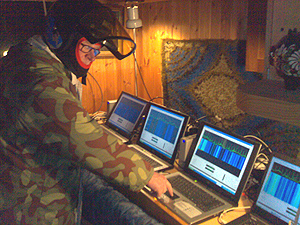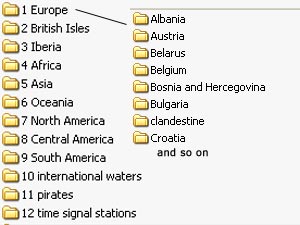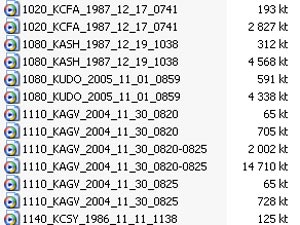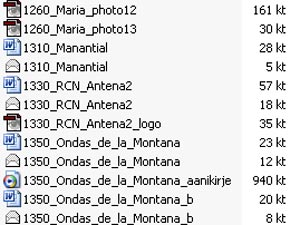|
Organizing Your Digital DX
by Mika
Mäkeläinen
Cheap digital storage space
has revolutionized the way we DXers can save, organize
and access our recordings and QSL collection. Creating
a digital DXing archive however requires many decisions
concerning formats and file names, with long lasting
consequences. This article explains the many mistakes
I have made, and how I have tried to resolve practical
problems related to going digital.
Most DXers record their
best catches, send reception reports and collect
verifications received from radio stations. All
of these stages can be done in various ways, with
the digital revolution making matters both more
efficient and user-friendly. The transition to a
fully digital DX collection is however not an easy
one - and the longer you have been DXing, the more
complicated digitizing your collection is.
Recording the highlights
I started recording station identifications,
sending reception reports and collecting QSLs in
1980. In the 80's I unfortunately saved only very
few recordings, which in hindsight was a major mistake.
Another mistake was to focus only on the rare catches.
Many of the common shortwave broadcasting stations
of those days don't even exist today, and I don't
have any recordings of these historical stations.

You can never record too
much - can you? |
Lesson number one: you can never
record and save too much. However, this was only
true until the advent of software defined receivers
(SDRs) - now you can indeed record and save way
too much, but more about that later.
Until the late 1990's I saved
my recordings on cassettes. Then came Minidiscs,
which I used to archive station identifications
until 2003. In 2003 digital storage space in the
form of hard drives started to become cheap enough
so that I began to digitize my vast collection of
radio recordings.
Delving into my cassettes, I
thought this would probably take a couple of weeks
of fulltime work. How wrong can you go. That was
four years ago, and I've completed maybe two thirds
of the job. To be honest, the process is complicated
by the fact that I want my digital sound files to
include information not readily available: I need
to consult my old logbooks to find out the exact
dates and times of my recordings.
In any case, I'm glad I started
digitizing sound files early - the digital files
are so easy to access now. I don't bother to browse
my cassettes any more, not even to send follow-up
reports, because it seems to take ages to find what
I'm looking for.
Choosing a popular format
and organizing files
The first issue to consider was format. Real media
format was already on the decline, while MP3 was
rising in popularity. From the start I decided that
the format must be a market leader (so that I can
hopefully find software to play my recordings 20
years from now, or at least to convert them to another
format) and light (so that recordings can be emailed
to stations and fellow hobbyists).
After mistakenly betting on Real
Media, I eventually decided to use both MP3 (.mp3)
and Windows Media (.wav) - I would immediately record
each clip in both formats. I would use the MP3 files
for emailing clips and Windows Media to have a higher
quality master file. Even though file size is no
longer an issue, there's no need to make clips any
larger than necessary. The sampling rate is not
so crucial as DX recordings are already noisy. And
since the original is mono, there's no sense to
record in stereo.

Sound files are arranged
in folders by continent, country and state |
There are countless recording
software on the market. My choice was Polderbits
Sound Recorder and Editor, which is very easy
and fast to use. It has an equalizer, and a couple
of filters, and also works as a converter between
formats. After a trial period the software costs
30€/$40. I am already so used to Polderbits
that I wouldn't be able to objectively compare it
to competing software, so you better do your own
research on the Internet before deciding what's
best for you.
I normally record the station
ID, sometimes including other announcements and
some music, with a short fade-in and fade-out. Here
are two MP3 samples, an Alaskan station KASH Anchorage
on 1080 kHz, when I first heard it in Finland back
in 1987,
and again in 2005,
with new call letters KUDO.
A crucial issue to consider is
how to name the sound files. My idea was to name
files so that exactly the same file names could
be used on the Internet, because that would be the
channel to share them - so no spaces between words
but underscore instead. Looks ancient, but works
universally.

Sound files (in this case
from Alaska) arranged automatically by frequency,
calls, date and time |
The number of files is bound
to explode, so you better come up with a logical
folder and naming system from the start. I have
chosen a folder structure based on continents at
the first level, then divided into countries and
further in some cases into states. In each country/state
folder, the station sound files are automatically
listed in order by frequency, station name/call
letters, date (year_month_day) and time (UTC). In
many cases I have a number of recordings from the
same station, and this helps to keep everything
in neat order. I have separate folders for unidentified
stations. Any clip is just a few clicks away, as
long as I remember the frequency of the station
- and since I focus on mediumwave (AM) DXing, it
is relatively easy.
I'm not claiming that this would
be the best way to organize files, it is just the
one I came up with. Considering the amount of files
already in my folders, I probably wouldn't change
anything even if I learned of a better system. Something
to consider before you spend hundreds of hours organizing
your digital DX - the last thing you want to do
after organizing your collection is to start reorganizing
it.
You can get away with a messy
collection by using an efficient search such as
Google
Desktop Search, as long as you have at least
something unique and easy to remember in the file
name, but - with my poor memory - I have found the
above structure to be very useful.
My first media files in the late
90's were only named after the station name. Getting
organized didn't matter as long as I was dealing
with only dozens or hundreds of recordings. However,
I currently have about 9000 clips of station identifications
from over 3000 different stations, so it was important
to come up with a scalable solution.
Software-defined receivers (SDR) have brought a
whole new dimension into recording. For instance,
the SDR-14/SDR-IQ
receiver equipped with Spectravue
software can record a 196-kiloherz wide section
of the band. A recording of just under 46 minutes
produces a 2 GB sound file. I have preserved some
of these files even after extracting the interesting
station identifications, because they allow you
to relive some memorable DXpedition conditions,
and also make it possible to toy with notch, AGC
and filter bandwidth later on.
As storage space is really no
longer a cost issue, it could be tempting to save
everything you ever heard or recorded. However,
I doubt I would ever want to go that far, because
no one, not even me, would ever want to listen
to all of those recordings.
An internet connection gives
more opportunities. If you have enough storage space
online, you - or anyone you want to allow - can
now access, print and play your files from anywhere
in the world. Occasionally when I have visited radio
stations it has been nice to be able to play their
ID straight from my online ID collection.
Composing and emailing reception
reports
So now you've got the recording
of that rare catch, neatly named and organized.
Sending a reception report just became easier. I
admit that I have been slow to adopt sending reception
reports by email, and only for the past year have
I sent the majority of my reception reports by email.
I have however included my email address in my reception
reports as long as I've had one, so I received my
first email QSLs (eQSLs) already in 1995.
Feeling nostalgic about printed QSL cards and letters,
I preferred them over emails, and for years I was
willing to go through extra trouble for getting
my QSL delivered by mail. In much of the world email
has however become a standard in business communication.
And it is the greener option. Not wanting to make
it difficult or expensive for stations to respond,
I have given up. If the station has an email address,
that would nowadays be my first option to deliver
a report. And sending follow-up reports is of course
easier than ever - at least if you have your clips
organized...
Until now I have basically used the same template
and text in email reports as in letters, but I have
a hunch that shorter emails would work better, and
so now I'm trying to be more concise. I would always
attach a family photo and an MP3 sound file along
with the email.
I would still like to think that
reception reports are not spam, and because of spam
filters, it makes sense to edit them so they don't
appear to be spam. My over-sensitive spam filters
have swallowed even eQSLs, so the same is probably
happening occasionally at the other end to my email
reports. Based on the criteria spelled out by my
spam filter, trivial issues like addressing the
recipient as "Dear", and including internet
links, can increase the probability that the email
is regarded as spam, so it pays to tailor your message.
Archiving
email verifications

This is a folder excerpt
from Colombia. My eQSL archive consists of various
file types, with stations listed in frequency
order. |
Initially
I used to just file all eQSLs to one of my email
folders. Soon I however started to save them in
two different formats, because the email as such
looks lousy in a collection. The first would be
in .eml file format, making sure all the header
details were included - an original, sort of. Attached
sound files, pictures etc I would save as separate
files. I would then open the email file in a text
editor, and edit further in MS Word, attaching whatever
visual material was at hand to make it look better.
If the eQSL included a logo or a picture, I would
copy and paste it to this fancier version of the
eQSL. If not, I would check if the station has a
website and copy a logo, a photo or a coverage map
from there. Finally, I add a headline with the station
name, location and frequency.
For an example of what it looks like, check
out the original
text file of my eQSL from KAGV on 1110 kHz from
Alaska, and the enhanced MS
Word version, which is the one I have printed
out for my QSL collection. (Note: the original text
file will show the headers only if you load it with
your email software, otherwise you'll only see the
message.) The MS Word version comes with reduced
header details, although personally I like to include
the message ID number for the sake of
proving authenticity.
The eQSLs are arranged in a folder
and file structure similar to the sound bites described
earlier. As over 90% of my QSLs nowadays arrive
by email, I need to keep them in some kind of order.
The total number of files in my eQSL collection
is now around 2900, probably from around 1000 different
stations.
Saving
for the future
Archiving the vast collection
of traditional printed QSL letters and cards as
digital image files is something that I plan to
do eventually, but not in the near future. Scanning
everything would take so much time that it sounds
like a project I will have to put off until retirement,
although I would really like the idea of having
an electronic copy of the original QSLs, because
of both sharing and security.
One of the major benefits of
digital material is of course that it is easy to
duplicate. Since all it takes is to copy the files,
it makes sense to have a backup copy of your entire
hard drive, preferably in another location, away
from home. This would protect your valuable collection
even in case of a fire, flood, theft, or whatever
your potential calamities might include.
Also, digital would be the way
to go if we DXers plan to save something for future
generations. Storing a few hundred gigabytes is
easier than an office room loaded with the original
treasures. There are at least a couple of QSL Museum
initiatives around the world, but for the majority
of QSLs out there, their fate depends on our offspring,
and our grandchildren may not appreciate having
to store endless piles of more or less historical
postcards. Sadly. Not that the digital storage options
available today would necessarily be any more permanent.
In any case, I expect that it won't be long before
we see the first digital DX legacy on the Internet.
What I mean is that someone will post his QSL and
audio collection highlights not just for fellow
hobbyists to enjoy right now, but specifically aimed
at future generations, when shortwave broadcasting
is already history.
Work for retirement
Unfortunately my eDX collection
is not as well organized as it may sound. Aside
from recordings, reception reports and eQSLs it
would be helpful to have a database of the entire
QSL collection. I only have Microsoft Word files
listing my verified stations by continent and country,
including details such as frequency, calls and date
of reception. I can easily find out what and how
many verified stations I have from each country
and state, but that's pretty much it.
Another big mistake. I should
have started using Excel, at least, or preferably
a database software, right from the start. It would
be interesting to be able to compile statistics
and graphs of the collection, document and demonstrate
trends, and get a grip of the essential characteristics,
but documenting the QSL collection all over again
is a task that feels a bit too overwhelming at the
moment. One more chore to
do when I retire.
Published
on November 20, 2007
  
|